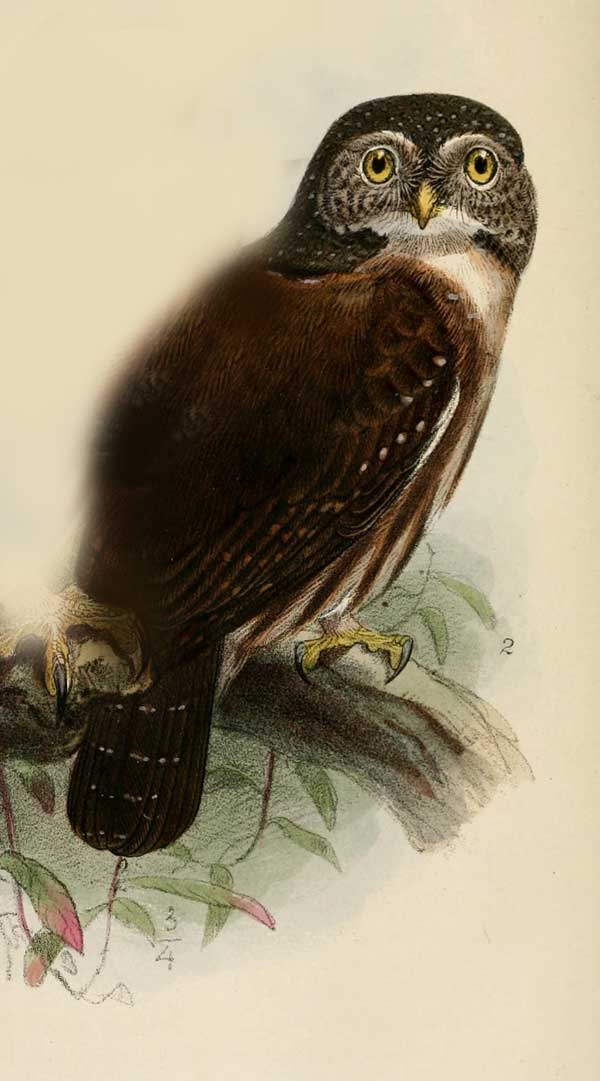
Glaucidium griseiceps
Superregnum: Eukaryota
Cladus: Unikonta
Cladus: Opisthokonta
Cladus: Holozoa
Regnum: Animalia
Subregnum: Eumetazoa
Cladus: Bilateria
Cladus: Nephrozoa
Superphylum: Deuterostomia
Phylum: Chordata
Subphylum: Vertebrata
Infraphylum: Gnathostomata
Megaclassis: Osteichthyes
Cladus: Sarcopterygii
Cladus: Rhipidistia
Cladus: Tetrapodomorpha
Cladus: Eotetrapodiformes
Cladus: Elpistostegalia
Superclassis: Tetrapoda
Cladus: Reptiliomorpha
Cladus: Amniota
Classis: Reptilia
Cladus: Eureptilia
Cladus: Romeriida
Subclassis: Diapsida
Cladus: Sauria
Infraclassis: Archosauromorpha
Cladus: Crurotarsi
Divisio: Archosauria
Cladus: Avemetatarsalia
Cladus: Ornithodira
Subtaxon: Dinosauromorpha
Cladus: Dinosauriformes
Cladus: Dracohors
Cladus: Dinosauria
Ordo: Saurischia
Cladus: Eusaurischia
Subordo: Theropoda
Cladus: Neotheropoda
Cladus: Averostra
Cladus: Tetanurae
Cladus: Avetheropoda
Cladus: Coelurosauria
Cladus: Tyrannoraptora
Cladus: Maniraptoromorpha
Cladus: Maniraptoriformes
Cladus: Maniraptora
Cladus: Pennaraptora
Cladus: Paraves
Cladus: Eumaniraptora
Cladus: Avialae
Infraclassis: Aves
Cladus: Euavialae
Cladus: Avebrevicauda
Cladus: Pygostylia
Cladus: Ornithothoraces
Cladus: Ornithuromorpha
Cladus: Carinatae
Parvclassis: Neornithes
Cohors: Neognathae
Cladus: Neoaves
Ordo: Strigiformes
Familia: Strigidae
Subfamilia: Surniinae
Genus: Glaucidium
Species: Glaucidium griseiceps
Subspecies: G. g. griseiceps - G. g. occulatum - G. g. rarum
Name
Glaucidium griseiceps Sharpe, 1875
References
Ibis - the International Journal of Avian Science, published by the British Ornithologists' Union p. 41 pl.2 fig.2
Vernacular names
čeština: Kulíšek šedohlavý
English: Central American Pygmy-owl
suomi: Keskiamerikanvarpuspöllö
The Central American pygmy owl (Glaucidium griseiceps) is a species of owl in the family Strigidae. It is found in Belize, Colombia, Costa Rica, Ecuador, Guatemala, Honduras, Mexico, Nicaragua, and Panama.[3]
Taxonomy and systematics
The International Ornithological Committee (IOC) treats the Central American pygmy owl as monotypic. However, the Clements taxonomy and Handbook of the Birds of the World recognize three subspecies, the nominate Glaucidium griseiceps, G. g. occultum, and G. g. rarum.[3][4][5]
Description
The Central American pygmy owl is 13 to 18 cm (5.1 to 7.1 in) long. Males weigh 50.6 to 58.8 g (1.78 to 2.07 oz) and females about 56 g (2.0 oz). Adults' crown and nape are grayish brown; the crown has buff to whitish spots and the nape dark "false eyes". Their upperparts and tail are rich brown and the tail has pale bars across it. Their underparts are whitish with reddish brown streaks. The juvenile's crown and nape are gray; the crown is unspotted and the nape's false eyes are sooty.[6]
Distribution and habitat
The Central American pygmy owl is found from Veracruz, Oaxaca, and Chiapas in southern Mexico through Guatemala, Belize, Honduras, Costa Rica, and Panama into northwestern Colombia with a gap in central Nicaragua. A disjunct populations is in far northwestern Ecuador. It inhabits lowland and foothill humid tropical evergreen forest, secondary forest, semi-open areas, and mature cacao plantations. In elevation it ranges from sea level to 1,200 m (3,900 ft) in Mexico and Honduras, 1,300 m (4,300 ft) in Guatemala, and 800 m (2,600 ft) in Costa Rica. In Ecuador it is known only between 200 and 600 m (660 and 1,970 ft).[6]
Behavior
Feeding
Though the Central American pygmy owl is primarily nocturnal, it also often hunts in daytime. Its diet is poorly known but is thought to be large insects, other invertebrates, and small lizards, birds, and mammals.[6]
Breeding
The Central American pygmy owl's breeding phenology is almost unknown. It has been reported to lay a clutch of two to four eggs in April and May, using a natural cavity or old woodpecker hole for the nest site.[6]
Vocalization
Dickcissel male perched on a metal pole singing, with neck stretched and beak open.
Songs and calls
Listen to Central American pygmy owl on xeno-canto
The Central American pygmy owl's song "begins with 2–4 equally spaced hoots, followed by [a] very brief pause, then [a] series of 6–18 very similar notes, 'huu-huu, huu-huu-huu...'". It is sometimes preceded by trills.[6]
Status
The IUCN has assessed the Central American pygmy owl as being of Least Concern. Its population is unknown but is believed to be stable.[1]
References
BirdLife International (2016). "Central American Pygmy-owl Glaucidium griseiceps". IUCN Red List of Threatened Species. 2016. Retrieved 6 September 2021.
"Appendices | CITES". cites.org. Retrieved 2022-01-14.
Gill, F.; Donsker, D.; Rasmussen, P. (July 2021). "IOC World Bird List (v 11.2)". Retrieved July 14, 2021.
Clements, J. F., T. S. Schulenberg, M. J. Iliff, S. M. Billerman, T. A. Fredericks, J. A. Gerbracht, D. Lepage, B. L. Sullivan, and C. L. Wood. 2021. The eBird/Clements checklist of Birds of the World: v2021. Downloaded from https://www.birds.cornell.edu/clementschecklist/download/ Retrieved August 25, 2021
HBW and BirdLife International (2020) Handbook of the Birds of the World and BirdLife International digital checklist of the birds of the world Version 5. Available at: http://datazone.birdlife.org/userfiles/file/Species/Taxonomy/HBW-BirdLife_Checklist_v5_Dec20.zip [.xls zipped 1 MB] retrieved May 27, 2021
Holt, D. W., R. Berkley, C. Deppe, P. L. Enríquez, J. L. Petersen, J. L. Rangel Salazar, K. P. Segars, K. L. Wood, G. M. Kirwan, and J. S. Marks (2020). Central American Pygmy-Owl (Glaucidium griseiceps), version 1.0. In Birds of the World (J. del Hoyo, A. Elliott, J. Sargatal, D. A. Christie, and E. de Juana, Editors). Cornell Lab of Ornithology, Ithaca, NY, USA. https://doi.org/10.2173/bow.capowl1.01 retrieved September 6, 2021
Additional reading
König, Claus y Friedhelm Weick: Owls of the World. Christopher Helm, London 2008, ISBN 978-0-7136-6548-2
Retrieved from "http://en.wikipedia.org/"
All text is available under the terms of the GNU Free Documentation License

